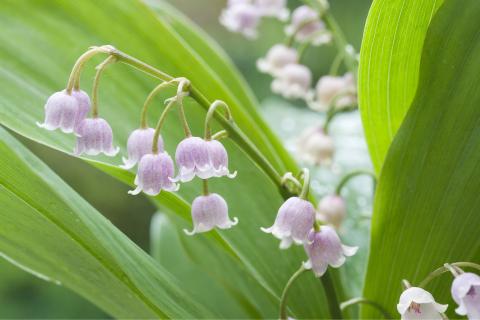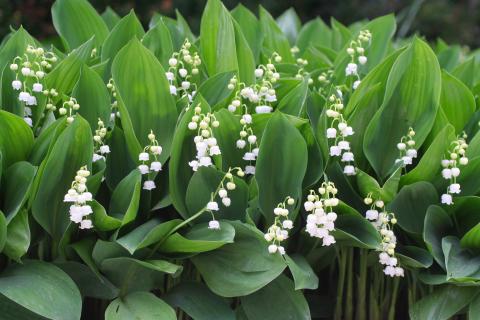Lily of the valley
Lily of the valley enchants us in the spring with its snow-white, fragrant flowers. If you don’t want to wait until May for this beautiful shrub, you can pre-cultivate the perennial plants between November and the start of December and leave them to flower on a window ledge.
Factsheet
- Growth type
-
- Perennial plant
- Growth height (from)
- from 15 cm to 20 cm
- Growth width (from)
- from 0 cm to 0 cm
- Growth characteristics
-
- flat growing
- foothills
- Flower color
-
- white
- Flowering time (month)
-
- May
- Flower shape
-
- Bells
- Cluster
- Fragrance
-
- 2
- Leaf color
-
- green
- page format
-
- elliptiques
- Light
-
- scattered light to semi-shade
- Soil type
-
- sandy to loamy
- Soil Moisture
-
- moderately dry to fresh
- ph value
-
- alkaline to weakly acidic
- Lime compatibility
-
- lime-loving
- Nutrient requirements
-
- moderately nutritious
- Decorative or utility value
-
- Flower Decoration
- Fruit ornaments
- picturesque growth
- native wild plant
- Toxicity
-
- highly toxic
- Winter Hardness
-
- hardy
- Use
-
- Bouquets
- Group planting
- Lawn areas
- Underplanting
- Wilderness
- Garden style
-
- Flower garden
- natural garden
- Park area
- Forest Garden
- Bee Friendly
- bee friendly plant
Lily of the valley (Convallaria majalis) is native to Europe, Asia, and North America. It grows in deciduous forests - predominantly in beech forests - and in meadows. This hardy, herby plant can also be found in mountains, at heights of up to 6233.6 feet, where it generally grows in large groups.
The perennial shrub originates from the Asparagaceae family and belongs to the Convallaria genus. The Latin genus name means “valley cauldron”, indicating the original source of the plant. The species name majalis relates to the flowering period which starts in May, around the same time as Mother’s day. Consequently, lily of the valley is a popular classic in Mother’s day bouquets. However, you should take care not to pick wild growing lilies of the valley outside of your own garden, as these are under natural protection.
Lily of the valley grows 5.91 to 9.84 inches tall. In the spring, lanceolate, long leaves sprout from the long-lasting rootstock that can be easily mistaken for wild garlic. An odor sample brings certainty: Wild garlic has a strong, garlic-like scent. The top and bottom sides of lily of the valley leaves both have a dark green color; the top side is noticeably shiny, the arch-shaped leaf veins in particular are immediately noticeable. The leaves grow merged together in pairs, there is a flower stem between them that bears five to 13 bell-shaped, white flowers from May to June. A particularly unusual and easy-care variety is the garden lily of the valley ‘Rosea’ that adds beautiful accents to the flower bed with its light-pink flowers.

Vibrant red berries from the pleasantly sweet scented flowers - all of which face in the same direction - in July, each of which contains between two and six seeds. These are a useful source of nutrition for blackbirds and other birds. However, for humans and some animals, such as pigs and goats, all parts of the plant are poisonous.
Lily of the valley has medicinal applications, despite its toxic properties: The dried, over-ground plant parts contain cardiac glycosides, similar to strophanthin, but less poisonous. You can take this kind of preparation for heart diseases - after consultation with a doctor. Previously, lily of the valley was used as a component in snuff as well as in the prevention and post-treatment of strokes and epilepsy. In fine art, lily of the valley is a symbol for medicine and for chaste love, humbleness, and modesty. This respectable plant also has a home in literature, as it was mentioned by numerous poets such as Eichendorff and Fallersleben and also inspired works of art by others.
Lily of the valley predominantly grows in deciduous forests in western and central Europe. In order to be able to grow well, the plant prefers a semi-shady to shady location as well as damp, warm, humus-rich soil. Humus can be worked into the garden bed in the form of compost soil. A soil containing loam and sand with an acidic pH value between 4.5 and 6 is ideal. Lily of the valley is also at home under the semi-shade of decorative bushes and trees, so there are lots of planting options.

Lilies of the valley are mainly used to underplant groups of bushes or trees in the garden. The small shrub provides a recurrent beautiful sight each year in amongst tulips and grape hyacinths. It is also well suited as a slender cut flower in bouquets as a Mother’s day gift or to decorate a vase. You must only take care that children and animals do not drink the water from the vase, as the poisonous plant substances transfer into the water after a period of time.
Lily of the valley is one of the less demanding plants, the only thing it cannot withstand is strong rays of sunshine. Young plants must be sufficiently watered to grow well. After lily of the valley has flowered, the inflorescences are removed; the dark green leaves remain in the summer and continue to have a decorative effect with their vibrant color. Lily of the valley should be mulched with a thick layer of leaf mulch or mature compost in the fall to keep the shrubs bushy, they do not require any additional fertilizer. If the plants spread too extensively with their rhizomes, you can reduce the growth area at any time with a spade.

Lilies of the valley are best propagated in June or July. During this period the roots lie flat on the soil and they can be loosened from the soil at the edges by hand. Then raise the plant with a shovel and dig it out. As lilies of the valley are very robust, it’s no big deal if a few roots are damaged in the process. Now the plant can either be potted or planted in another spot in the garden.
Alternatively, individual root pieces can be cut off, placed in soil about 3.94 inches deep, and the planting holes filled with compost. If you would like to see the first flowers in the winter, you can divide the rhizomes in the fall and leave them to pre-cultivate on the window ledge. Around six new plants will develop from a root ball of around 5.91 inches. After flowering the new lilies of the valley can be planted in their future location outdoors.
Some lilies of the valley are infested by the rust fungus Puccinia sessilis var. sessilis infested. As with most fungal diseases, this can only be successfully combatted in the initial stage. This is done by removing and destroying infested leaves and plant parts. Ideally, the affected plant material should be burned. If this is not possible, dispose of the plant material in the household garbage. Do not dispose of the material in the compost as this can lead to the fungus spreading further. Any garden equipment and tools used should be thoroughly cleaned and disinfected before the next use.
An infestation of gray mold (Botrytis cinerea) is less common. However, if the plants do become sick, the affected parts must be treated, as otherwise the plant will rot and the fungal spores could be transferred to other plants. A potassium-heavy fertilizer is good at preventing a possible infestation.

The scarlet lily beetle may also cause damage to lily of the valley as larvae or adult bugs. The 0.24 to 0.31 inch large insects are shiny and bright red. An environmentally-friendly method of getting rid of these small bugs is to collect them from the affected plant by hand. The larvae are found on the underside of the leaves and can be easily rinsed off with a garden hose. Once they are on the soil they cannot find their way back. Spreading coffee grounds around the plant also sends the bothersome insects packing in most cases.

